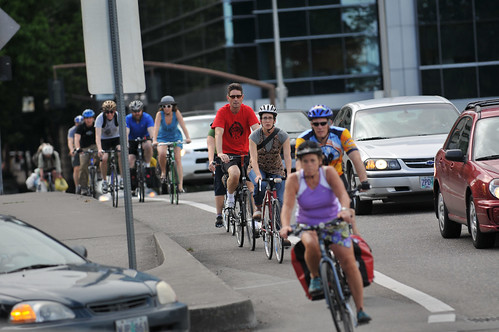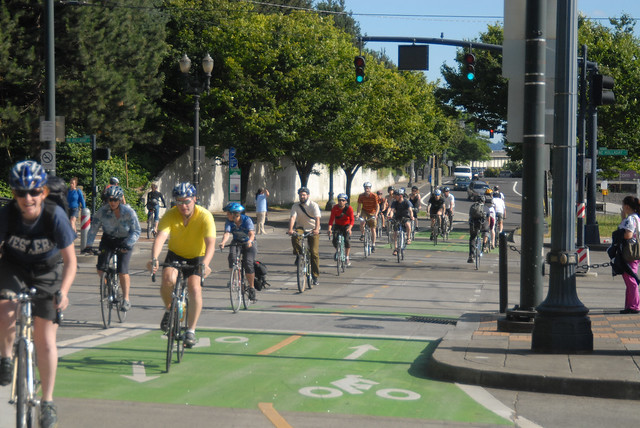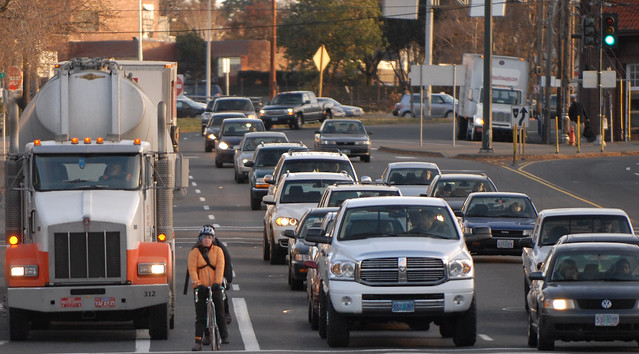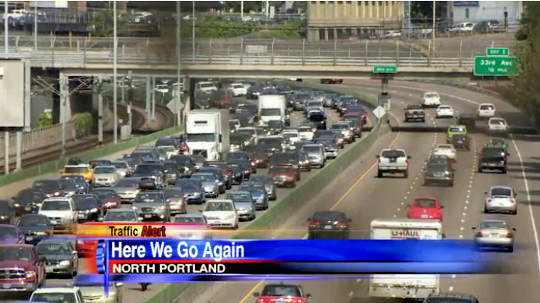This post is sort of inspired by Randall Munroe.
It’s an idea that pops up now and then in the bike world: What if, one morning, we all drove cars instead?
That’d teach the naysayers a lesson.
Or would it?
Well, let’s find out.
How many bike commuters own cars?
Here’s the first thing to figure out: How many people riding bikes to Portland jobs actually have cars at home?
As with a lot of these questions, a Census data set released last fall, covering the years 2006-2010, is going to be a huge help here. Though the share of bike commuters is somewhat higher today than in the early years of that period, it’s not a dramatic difference, so the demographics of who’s biking probably haven’t changed a ton.
Of 15,130 people who biked to Portland jobs over those years, 2,460 didn’t have cars at home, and another 5,730 lived in one-car households. According to different Census data, 47 percent of one-car households in the Portland area have two workers; let’s assume this ratio holds for households with bike commuters, and that such households are evenly split between those where both workers leave the car at home and those where one worker car-commutes while the other bikes.
Let’s also assume that 350 bike commuters who don’t own cars managed to commandeer every single car2go in the city for one day.
2,460 people from no-car households biking to jobs in Portland
5,730 bike commuters in one-car households x 47% with a second worker x 50% where the second worker takes the car = 1,347 other bike commuters without car access
350 bike commuters taking car2go
2,460 + 1,347 – 350 = 3,457 bike commuters who couldn’t drive to work even if they wanted to
15,130 Portland bike commuters – 3,457 without car access = 11,673 Portland bike commuters with car access as of 2006-2010 (which means about 75% of Portland bike commuters have access to a car)
As I mentioned, the number of bike commuters to Portland jobs has increased somewhat since then: from about 15,130 to 18,584 as of 2012, a 23% increase. We also know that typical Hawthorne Bridge bike counts haven’t risen since 2012, so let’ s assume the 2012 numbers hold:
11,673 * 123% = 14,357 Portland bike commuters with car access today
Dreaming about a show of strength? If you could get every bike-commuter in Portland to join, that’s how many commute cars you’d be adding to the roads.
How many cars are on the road already?
This question is easier. As of 2012 we had 271,932 drive-alone commuters, 32,384 people in two-person carpools, 7,201 in three-person carpools and 2,092 in carpools of four or more. So:
271,932 + 1/2 of 32,384 + 1/3 of 7,201 + 1/4 of 2,092 = 291,047 cars headed to Portland jobs
Yikes. That’s a lot of cars. How much difference would the “day without the bicycle” make?
14,357 / 291,047 = 4.9 percent more cars if every biker with car access drove to work
What would that look like? Well, here are a couple moderately crowded downtown Portland intersections, roughly to scale, with 50 cars:
And here’s what they would look like with 4.9 percent more, 53 cars:

Hm.
What if we look specifically at downtown?
But maybe we’re giving bikes short shrift. What if we look specifically at the part of Portland with the most bike commuters: downtown?
Let’s look at the four Portland Census tracts with the most bike commuters: the central business district south of Burnside (2,530 bike commuters), Old Town north of Burnside (700 bikes), the Pearl area (515) and the Portland State University area (495).
2,530 + 700 + 515 + 495 = 4,240 bike commuters downtown as of 2006-2010
4,275 x 123% = 5,215 bike commuters downtown today
Advertisement
But because Census numbers don’t include students, let’s also count the 2,651 PSU students who bike to class (keeping in mind that many don’t actually commute every day and that for many, it’s a very short distance).
5,215 + 2,651 = 8,653 bike commuters downtown including PSU students
Now, of those, how many could drive if they wanted to? We’ll assume the downtown workforce follows the metro-area trend and that 75 percent of bike commuters have car access, plus 20 percent of PSU students. (We’re ignoring parking here: PSU and many downtown garages are pretty close to their daily parking capacity. But if we filled every street space and garage and also evicted every food cart, maybe this could fit.)
5,215 x 75% = 3,911 downtown worker bike commuters who could opt to drive
2,651 x 20% = 530 PSU student bike commuters who could opt to drive
3,911 + 530 + 350 car2go users = 4,791 downtown commuters and PSU students who could opt to drive
How does this compare to the number of downtown and PSU commuters with cars? I’ll spare you the math, but using the same formula as above, downtown has 39,394 cars from workers and another 5,007 or so from PSU students. That’s 44,401 cars downtown.
4,791 / 44,401 = 11%
So this is our answer:
If every downtown bike-commuting worker and PSU bike-commuting student with car access drove to work on the same day, downtown car-commute traffic would increase about 11 percent.
(This assumes that zero cars are on the road for anything except commuting. If anybody were using cars for anything else, the congestion impact would be smaller.)
What does this look like? Here’s that image of 50 cars:
And here’s 55 cars:
Hmm.
Are you ready for this, Portland? Here’s the hard truth:
Even in Portland, an organized “day without the bicycle” would have very little effect on congestion.
Even in the bikingest part of the bikingest major city in North America, getting every single bike commuter with a car to drive to work for one day — a participation level that wouldn’t be anywhere close to achievable anyway — would barely increase auto traffic more than the normal day-to-day fluctuation on any given street. Overall, the impact would be 10 percent in the central business district, 11 percent in the Pearl, 9 percent in Old Town and 11 percent in the PSU area.
Epilogue: On the other hand
But before you get depressed, here’s the other side of the coin.
What is it, exactly, that “day without the bicycle” dreamers envision? Hours of mind-numbing congestion on our freeways? A huge gouge out of our regional labor productivity? Freight traffic crawling to a job-killing standstill?
This already happens in Portland. It happens every single day.
The real truth behind the “day without a bicycle” is that in the United States — even in Portland — every single day is a day without the bicycle.
Every single day is a day that people who truly need to drive are sitting in needless congestion.
Every single day is a day we’re killing jobs by trapping semis on needlessly congested freeways.
Every single day is a day when a huge share of the population could be reaping all the joys and benefits of getting where you need to go with your own muscles, but isn’t.
We don’t need more “days without the bicycle” in the United States.
We need many, many fewer.
– Read more of our Ask BikePortland columns here.












